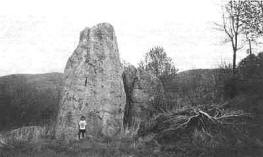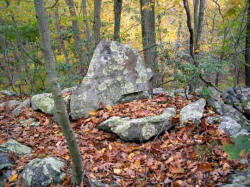|
Standing Stones & Slabs
North American standing (upright) stones range in height from a foot or two
on up to over 20 feet. A standing stone is defined as a
tall, generally narrow stone which has been planted in the ground,
although these are occasionally found balanced on a ledge
outcrop. Standing slabs are almost the same, except these
are broad, rather than narrow. Slabs are also found both
planted in the ground and balanced on edge on top of ledge
outcrops.
Two early accounts of Native standing stones:
An early Nineteenth Century discovery of a
cache of stone pillars; from: "A history of the old town of
Stratford and the city of Bridgeport, Connecticut,"
Rev. Samuel Orcutt, 1886 -
These pillars were "nearly round,
six and seven feet long, from seven to eight inches in diameter;
one is nearly square, only the corners rounded, . . . has a slot
from the top downwards about eight inches deep and half an inch
wide, on the side . . . . One of these posts is much larger than
any of the others, and is of oval shape, from ten to twelve
inches wide and about seven thick." The conclusion at
that time was these pillars were for a Native medicine (or
powwow) ring. [Some of these stones are preserved as fence
posts on the grounds of the Stratford, CT Historical Society.]
Early Western Journals 1748-1846; R.G.
Thwaites, editor; 1904; note, p. 22:
“. . . [Weiser] crossed the
Juniata River, and approached the ‘Standing Stone.’ This was a
prominent landmark of the region, and stood on the right bank of
a creek of the same name, near the present town of Huntingdon
[PA]. It was about 14 feet high, and six inches square, and
served as a kind of Indian guidepost for that region.”
The original Standing Stone of Huntingdon,
erected by the Indians, was a granite column, about fourteen
feet high and six inches square, covered with strange
characters, which were the sacred records of the Oneidas. Once
the Tuscaroras stole it, but the Oneidas followed, and, fighting
for their sacred treasure, recaptured it. When the whites came
along, the Oneidas, who had joined the French, went west,
carrying the stone with them. Afterwards, a second stone, much
like the first, was set up, and a fragment of it is now
preserved at Huntingdon.

Standing Stone Monument in Monterey, TN
preserves the remains of an originally 12-foot tall stone.
The stone was a boundary marker for an Indian Treaty of 1785,
until 1805.
The stone was used as a boundary line between separate
Indian Nations. The Cherokee called the monolith "NEE YAH KAH TAH KEE" which is interpreted "Standing Stone."
A tomahawk and the words "NEE YAH KAH TAH KEE" were inscribed
on the monolith which now rests atop the monument. The monument
was dedicated on the 17th day of October, 1895. It
can be viewed in City Park in the center of Monterey.

Standing Stone State Park, original location of Nee Yah Kah Tah: "The park takes its name from a twelve foot
'dog shaped'
monolith."
 Photo of the Devil's Tombstone, OK

Florida- Crystal River Archaeological State Park, with two
stelae, one of which was erected c. 440 A.D.
 (photos here:
(photos here:
 )
) |
![]()


